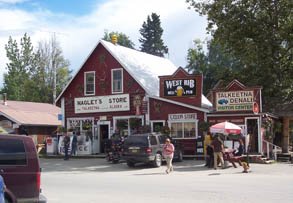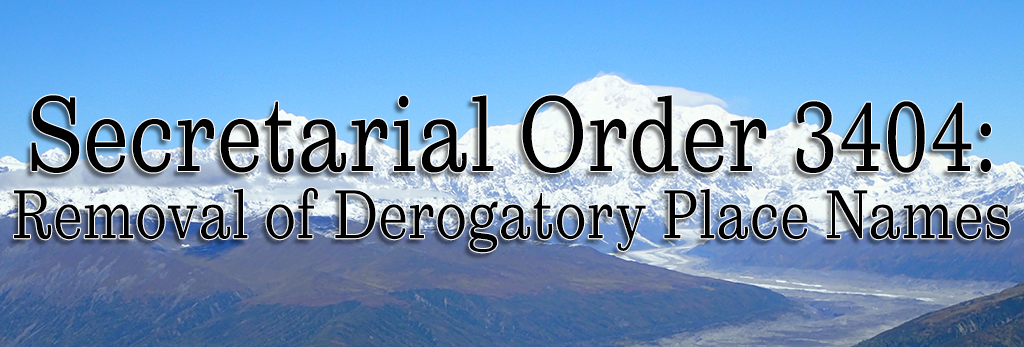Designations
National Register of Historic Places
The National Register of Historic Places is the nation's list of historic properties worthy of preservation. Authorized under the National Historic Preservation Act of 1966, the National Register supports public and private efforts to identify, evaluate, and protect historic and archaeological properties of local, state, or national significance.
Alaska Landmark Register
The Alaska Historic Preservation Act created an Alaska Landmark Register. The Alaska Historical Commission, the state review board, has established criteria and a process to create a list of properties important to the state's past. All properties listed in the National Register of Historic Places are Alaska Landmarks.

Geographic Names
Natives and Euro-American visitors and settlers gave names to many geographic features in Alaska. The Alaska Historical Commission is designated by statute as the state review board for names of lakes, streams, mountains, and other physical features. The commission coordinates with the U.S. Board on Geographic Names (USBGN) for name decisions for federal maps, particularly those of the U.S. Geological Survey (USGS). A record of officially recognized Alaska geographic names is in the Geographic Name Information System (GNIS).
Update: Secretary Haaland Takes Action to Remove Derogatory Names

On November 19, 2021, Secretary of Interior Haaland, formally declared per Secretarial Order 3404 "squaw” a derogatory term and created a Reconciliation in Places Names advisory committee to identify and replace additional derogatory names. https://www.doi.gov/sites/doi.gov/files/elips/documents/so-3404-508.pdf
Historically, this term has been used as an offensive ethnic, racial, and sexist slur, particularly for Indigenous women. According to the Board on Geographic Names, more than 650 federal units contain the term, and 27 are located in Alaska.
The Derogatory Geographic Names Task Force established by the Order included representatives from federal land management agencies and the Department of Interior diversity, equity, and inclusion experts. Dr. Michael Tischler was named chair of the task force. The Secretary's Order directed task force participants to engage in Tribal consolation and consider public feedback on proposal name changes.
Secretarial Order 3405 also created a Federal Advisory Committee to solicit broadly, review, and recommend changes to other derogatory geographic and federal land until names. (see Sec. Haaland Action to Remove Derogatory Names from Federal Lands, DOI News Release, November 19, 2021.)
To reconcile the names declared derogatory, DOI directed the U.S. Geological Survey to develop a list of geographic replacement names derived by searching nearby geographic features, adhering to the Board on Geographic Names "Principles, Policies, and Procedures" for the Domestic Names Committee. For example, named geographic features in the Dillingham Census Area situated near the declared derogatory "Squaw Creek" include "Bradford Point," "Grassy Island," "Snag Point," "Sheep Island," and "Picnic Point." Accordingly, the first candidate replacement name for the derogatory name feature would be "Bradford Creek," the second would be "Grassy Creek," and so on. (See S.O. 3404 for the complete list of candidate names)
Dr. Tischler expressed that DOI's aim was to get these name changes done quickly. If the public wishes to propose an additional candidate name, they can submit a formal comment via the Federal Register. Federal Register :: Reconciliation of Derogatory Geographic Names. The task force will then consider the local proposal, and those names will be prioritized. Dr. Tischler explained that Federally Recognized Tribes were notified process via letters. After the public comment period ends, the replacement names will go into effect. Dr. Tischler stressed that the replacement names are tentative and could be changed through more conventional processes. The public comment period opened on February 23, 2022, and is open for 60 days, ending on April 25, 2022.
Derogatory Feature Names in Alaska Interactive Map
To learn more about S.O. 3404 and the list of official features that will be changed, visit the U.S. Board of Geographic Names website at U.S. Board on Geographic Names | U.S. Geological Survey (usgs.gov)
The National Association of Tribal Historic Preservation Officers (NATHPO) and the Wilderness Society (TWS) co-sponsored “A Guide to Changing Racist and Offensive Names on Public Lands.” It provides a step-by-step tutorial on how to apply to name or rename offensive place names through the U.S. Board of Geographic Names – the official entity responsible for naming lakes rivers and mountains in the United States. The free guide also provides advice for engaging Tribes, local communities, and state naming authorities.
A guide to changing racist and offensive names on public lands | The Wilderness Society
For questions, please contact OHA’s Geographic Names coordinator, Katie Ringsmuth at katie.ringsmuth@alaska.gov or 907.269.8714.
To learn how to change a name or propose a new name for a previously unnamed geographic feature, please review Alaska's Geographic Name Guidelines. For questions or assistance, please contact the Office of History and Archeology at 550 W. 7th Ave, Suite 1310, Anchorage, Alaska 99501-3565; or email dnr.oha@alaska.gov
Please submit the complete application, maps, and supporting documents to OHA. You can find the application here: PROPOSAL TO NAME A GEOGRAPHIC FEATURE IN ALASKA.
To learn more about Alaska’s Geographic Name program, please visit: Geographic Names
To lean about the U.S. Board on Geographic Names visit: U.S. Board on Geographic Names | U.S. Geological Survey (usgs.gov)
Incentives
Grants
Ten percent of the annual Historic Preservation Fund grant to Alaska is for Certified Local Government (CLG) projects. The Office of History and Archaeology solicits applications, and the Alaska Historical Commission reviews them based on priorities it establishes and makes recommendations of awards to the State Historic Preservation Officer. Survey, inventory, preservation planning, National Register nomination, public preservation education, predevelopment, development and acquisition projects are eligible for program funds.
On occasion, the Office of History and Archaeology has Historic Preservation Fund grants for owners to assist with predevelopment and development work on historic properties. These funds are for properties listed in the National Register of Historic Places. When available, a call for project proposals is advertised statewide. The Alaska Historical Commission reviews the applications and makes recommendations of awards to the State Historic Preservation Officer. More information on these grants can be found here.
Federal Tax Credits
The Federal Historic Rehabilitation Tax Credit gives a 20% tax credit (not just a deduction) to owners who rehabilitate certified historic buildings in accordance with the Secretary of the Interior's Standards for Rehabilitation. The Federal Historic Rehabilitation Tax Credit is based on a percentage of the rehabilitation costs.
